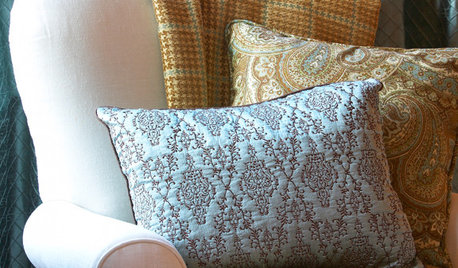Stiff Blankets
touchtoplay
12 years ago
Related Stories

LIFEGo Ahead, Eat in Front of the TV
But at least do it stylishly. A favorite guilty pleasure turns sophisticated with seats, tables and screens designed for a mealtime show
Full Story
HOUZZ TOURSHouzz Tour: Patterns and Colors Flirt With Wood in Los Angeles
Rational exuberance reigns in this wood-filled Craftsman, thanks to well-considered shots of color and snazzy graphics
Full Story
DECORATING GUIDESTo Drape a Throw or Fold It?
Spilling softly or crisply creased, throws on chairs, sofas and chaises offer beauty and comfort
Full Story
FEEL-GOOD HOMESimple Pleasures: The Joy of Fresh Sheets
Make your bed a place of comfort and relaxation with good-quality linens, ample pillows and other pleasing accoutrements
Full Story
BEDROOMSHow to Choose the Perfect Bedsheets
Don't lose any shut-eye over scratchy or ill-fitting sheets; our mini guide to materials, thread count and fit will help you sleep tight
Full Story
UPHOLSTERYFabric Focus: Cozy Up to Fall and Winter With Wool Decor
Environmentally friendly, durable and insulating, wool is an all-around good pick for home furnishings
Full Story
GARDENING FOR BUTTERFLIESGreat Design Plant: Scotch Heather
The moors aren't all moody, as this prettily colored evergreen shrub proves. Plant it en masse for an epic romance in your own garden
Full Story
DECORATING GUIDESDitch the Rules but Keep Some Tools
Be fearless, but follow some basic decorating strategies to achieve the best results
Full Story
BEDROOMSRest Easy: Myth Busting for Bedding and Mattresses
We put to bed some of the misconceptions that may be keeping you from a good night's sleep
Full Story
TRADITIONAL HOMESHouzz Tour: A Historic Remodel Keeps the Romance Alive
It was love at first sight for the owner of a 2-centuries-old house. She and her husband renovated it with tender loving care
Full StorySponsored
Columbus Design-Build, Kitchen & Bath Remodeling, Historic Renovations
More Discussions









liriodendron
westvillager
Related Professionals
Montrose Kitchen & Bathroom Designers · Terryville Kitchen & Bathroom Designers · Wood River Kitchen & Bathroom Remodelers · Citrus Park Kitchen & Bathroom Remodelers · Cocoa Beach Kitchen & Bathroom Remodelers · Trenton Kitchen & Bathroom Remodelers · Black Forest Cabinets & Cabinetry · Buena Park Cabinets & Cabinetry · Lakeside Cabinets & Cabinetry · Newcastle Cabinets & Cabinetry · Romeoville Custom Closet Designers · Cincinnati Flooring Contractors · Hibbing Flooring Contractors · Moses Lake Flooring Contractors · White Bear Lake Flooring Contractorsmara_2008
touchtoplayOriginal Author
IFortuna